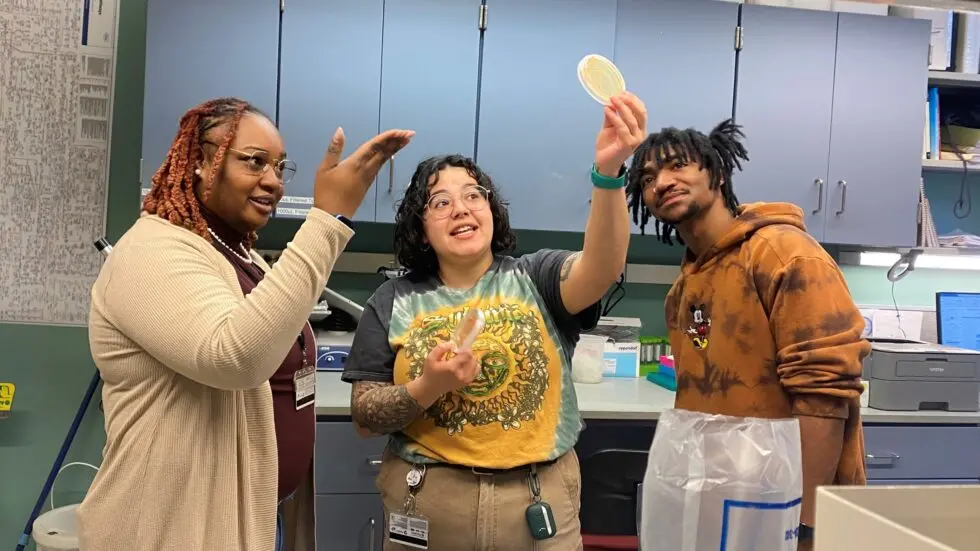
Biochemist Melanie McReynolds researches metabolism and aging, and the role of stress in that process. As a new Co-Investigator at the Center for Advanced Bioenergy and Bioproducts Innovation (CABBI), McReynolds will apply her expertise to yeasts, the tiny organisms that help transform plant material into bio-based fuels and chemicals.
McReynolds is an Assistant Professor of Biochemistry and Molecular Biology and the Dorothy Foehr Huck and J. Lloyd Huck Early Career Chair in Biochemistry and Molecular Biology at Penn State University, where she also earned her Ph.D. Much of her research focuses on nicotinamide adenine dinucleotide (NAD+), a powerful coenzyme in cells that regulates metabolism and is the center of metabolic deficiency and aging.

Metabolism comprises the set of life-sustaining chemical reactions in organisms, converting food into nutrients and energy to keep cells running. NAD+ fuels more than 300 biochemical reactions necessary for those energy-producing functions, and it binds with critical proteins related to longevity to help repair cells and DNA. But NAD+ levels decline with age, and disruption of NAD+ homeostasis is found in virtually all age-related diseases, including neurological decline, diabetes, and cancer.
McReynolds’ research addresses two questions: What are the primary control mechanisms that determine proper NAD+ concentrations and fluxes? And how do these mechanisms go wrong in aging and disease?
“We are broadly interested in understanding the biochemistry behind aging, and its intersection with stress, with the long-term goal of identifying strategies that promote healthier aging. Developing models to determine how stress disrupts NAD+ metabolism and homeostasis can shed light on this issue,” McReynolds said.
At CABBI, McReynolds will apply the same tools she uses to understand what makes and consumes NAD+ in mammals to the yeast strains developed for biofuel production. It turns out that humans and yeast share many similarities in this context.
“Basic metabolism in yeast is nearly identical to that in humans, especially in the way they age,” in terms of DNA integrity, response to nutrients, and other metabolic processes, she said.
The goal of CABBI’s Conversion Theme is to use yeasts to turn plants into high-value chemicals, such as biodiesel, organic acids, jet fuels, lubricants, and alcohols. A key challenge in engineering new yeast strains for that conversion process is the possibility of triggering an imbalance of cofactors or coenzymes like NAD+, which transfer electrons back and forth in a process known as “redox” metabolism (reduction-oxidation). Understanding what happens to redox metabolism as yeast cells age and experience stress will help scientists combat that problem and ultimately improve efficiency and yield.
Though she hasn’t worked with yeasts before, McReynolds is well-acquainted with CABBI. She was a Postdoctoral Researcher with Josh Rabinowitz, Professor of Chemistry at Princeton University and CABBI’s Deputy Theme Leader for Conversion research. Rabinowitz described her as a “dedicated scientist, committed educator, and engaging speaker.”
“Melanie brings a new perspective to CABBI’s research on redox metabolism, focusing on the fate of the NAD+ molecule itself — where does it come from? How is it consumed? And what are the biological and engineering consequences?” Rabinowitz said. “Melanie has made major contributions to answering these questions in worms and mice, and now she is poised to do so in yeast (and eventually plants). In the Conversion Theme, she will broaden our metabolic toolkit while also championing our mission of enhancing the bioeconomy.”
Her postdoctoral work provided a key piece of the puzzle as to why NAD+ declines with age. Previously, it wasn’t clear whether that was due to impaired synthesis or an increase in consumption of NAD+ by enzymes that respond to inflammation or DNA damage as we age. McReynolds used metabolomics and isotope tracing to determine that synthesis was not impaired at the whole body level. But NAD+ turnover grew faster with age, which supported the theory of hyperactivation of NAD+-consuming enzymes. This finding led McReynolds and other researchers to consider the impact of stress — emotional, physical, even environmental — on aging and metabolic decline, and how that makes us vulnerable to age-associated diseases.
McReynolds is already beginning to work with CABBI’s Costas Maranas of Penn State, an expert in computational modeling of cellular metabolism, and she is open to collaborations with researchers across CABBI who can use metabolomics or isotope tracing.

Her team includes graduate student Alexandria Murphy, who has in-depth experience working with yeasts as an undergraduate researcher at Portland State University; and undergraduate Donovan Mauney, a first-year Millennium Scholar at Penn State. Along with the biofuel work, Murphy hopes to better understand how climate change impacts health.
“With climate change there are increased pollutants and toxins in the air we breathe. Pollution has detrimental effects on our bodies’ natural aging processes and ability to fight off diseases. If we can manipulate yeast metabolism for optimal production for biofuel, then there is potential to decrease the pollutants in our air while simultaneously gaining insight into how climate stress impacts humans through a simple organism,” McReynolds said.
Yeasts may also help scientists understand aging in humans and other mammals. When yeasts reproduce, the metabolism of the “mother” yeast slows, and it exhibits signature chemical features considered “hallmarks of aging” in older mammals, she said. Since yeast is a simple, short-lived organism, scientists can easily conduct studies to understand redox metabolism in yeast and transfer that knowledge to humans.
Beyond its role in aging, NAD+ is a key to reproduction and development. McReynolds devoted her graduate research at Penn State to investigating the biosynthetic pathways involved in that connection. There are three key pathways from amino acids and metabolites that synthesize NAD+, and disrupting them can affect reproduction. Her work showed that when those pathways mutate, it blocks glycolysis, a series of reactions that extract energy from glucose. And that in turn disrupts reproduction, reducing the number of offspring for animals in McReynolds’ study.
In addition to the CABBI work, the McReynolds lab is continuing to study the role of NAD+ in reproductive aging. With more and more women having children in their late 30s and 40s, it’s crucial to understand how the uterus and other organs age and to help protect women from pregnancy complications, she said. McReynolds is also establishing a model of multiple myeloma, a cancer that affects people 65 years and older. Multiple myeloma cancer cells express CD38, one of the main NAD+ consumers that drives NAD+ decline with age and responds to inflammation. Cancer researchers see it as an immune marker, but McReynolds hopes to make the connection to NAD+ metabolism and aging, to provide new understanding and perhaps treatments for age-related cancers.
Both topics are personal for McReynolds. “I always cared about aging because I had older parents,” she said. Her mother was diagnosed with multiple myeloma as McReynolds was interviewing for jobs and considering that line of research. “She passed a couple of months later,” McReynolds said.
Her parents were both high school teachers in her rural hometown of Louisville, Miss., and were the first in their families to attend college, at Alcorn State University, a historically black university. McReynolds kept that family tradition alive, earning bachelor’s degrees in chemistry and physics from Alcorn State.
She was loved math and science from a young age, finding them both challenging and rewarding. But her school district lacked the resources to provide laboratory experiences.
Though she took every science class offered in high school, she had never performed an experiment until college — in a biomedical research lab in Bangalore, India. Through an academic partnership, the head of Alcorn State’s biological sciences department took 10 students a year to Indian institutions for summer research internships. McReynolds interned at St. John’s Medical College Institute of Population Health and Clinical Research in 2007, gaining valuable exposure to biomedical research and providing a solid foundation that confirmed her plans to be a scientist.
“Despite my steep learning curve, these programs and initiatives opened my eyes to the thrilling possibilities of scientific discovery and being an academic scientist,” she said. “It changed the trajectory of my career.”
That same professor recommended her for the Alcorn State to Penn State Bridges to the Doctorate Program, funded by the National Institutes of Health, which allowed students to earn master’s degrees from both institutions.
“It gave me the lifejacket I needed to really learn how to do well in graduate research,” McReynolds said.
Those experiences drove home the importance of early exposure to science and research and led McReynolds to mentor other students from underserved communities in urban or rural areas. It’s a lesson passed on by her mother, who regularly took busloads of high school students to visit colleges and treated them like her own children. McReynolds and Murphy hope to mentor undergraduates through CABBI’s Research Internship in Bioenergy (RISE) program in coming years.
“I was raised by a mentor,” McReynolds said. “I love to pay it forward, lift as I climb, and give back. That’s a really big part of who I am.”
— Article by Julie Wurth, CABBI Communications Specialist